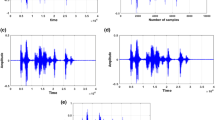Abstract
This paper investigates the effect of both decoding and decompression on the Speaker Identification (SI) in a remote access system. The coding and compression processes are used for the communication purpose as a normal action taken for voice communication over Internet or mobile networks. In the proposed system, the speech signal is coded with the Linear Predictive Coding (LPC) technique. Also, the speech signal is compressed using two techniques. The first technique depends on decimation process to compress the signal. The signal can be recovered using inverse solutions. The inverse solutions include maximum entropy and regularized reconstruction. The second technique is the Compressive Sensing (CS) and the speech signal can be reconstructed using linear programming. The coded or compressed speech signal is transmitted into the receiver via a wireless communication channel. At the receiver, the received signal is decoded or decompressed, and then SI is performed on the decoded or decompressed speech signal. The performance of coding and compression techniques is evaluated using some metrics such as Perceptual Evaluation of Speech Quality (PESQ) and Dynamic Time Warping (DTW). The objective of SI is to achieve the security needed for the remote access system, and this security can be increased using coding and compression processes. In the SI system, the feature vectors are captured from different discrete transforms such as Discrete Wavelet Transform (DWT), Discrete Cosine Transform (DCT), and Discrete Sine Transform (DST), besides the time domain. The recognition rate for all transforms is computed to evaluate the performance of the SI system.

















Similar content being viewed by others
References
Adel H, Zahran O, Taha TE, Al-Nauimy W, El-Halafawy S, El-Rabaie ESM, Abd FE. ECG Signal Compression Using A Proposed Inverse
Ahmed S (2011) Compressive Sensing for Speech Signals in Mobile Systems
Andrews HC, Hunt BR (1977) Digital image restauration
Bachu, R. G., Kopparthi, S., Adapa, B., & Barkana, B. D. (2008) Separation of voiced and unvoiced using zero crossing rate and energy of the speech signal. In: American Society for Engineering Education (ASEE) Zone Conference Proceedings (pp. 1–7)
Baraniuk RG (2007) Compressive sensing. IEEE Signal Process Mag 24:4
Bradbury J (2000) Linear predictive coding. Mc G. Hill, New York
Desai S, Nakrani N (2013) Compressive sensing in speech processing: A survey based on sparsity and sensing matrix. International Journal of Emerging Technology and Advanced Engineering 3(12):18–23
El-Khamy SE, Hadhoud MM, Dessouky MI, Salam BM, El-Samie FEA (2005) Regularized super-resolution reconstruction of images using wavelet fusion. Opt Eng 44(9):097001
El-Samie FEA (2011) Information security for automatic speaker identification. In: Information Security for Automatic Speaker Identification (pp. 1–122). Springer, New York
Ernest GD, Timothy AA, Kpangkpari G (2016) The Use of Remote Access Tools by System Administrators Today and their Effectiveness: Case Study of Remote Desktop, Virtual Network Computing and Secure Android App. Int J Comput Appl 136(10):35–38
Galatsanos NP, Chin RT (1989) Digital restoration of multichannel images. IEEE Trans Acoust Speech Signal Process 37(3):415–421
Hohage T (2002) Lecture notes on inverse problems
Honda M (2003) Human speech production mechanisms. NTT Technical Review 1(2):24–29
Hu Y, Loizou PC (2007) Evaluation of objective quality measures for speech enhancement. IEEE Trans Audio Speech Lang Process 16(1):229–238
Ikram, M., Vallina-Rodriguez, N., Seneviratne, S., Kaafar, M. A., & Paxson, V. (2016). An analysis of the privacy and security risks of android vpn permission-enabled apps. In: Proceedings of the 2016 Internet Measurement Conference (pp. 349–364). ACM.
Jagtap SK, Mulye MS, Uplane MD (2015) Speech coding techniques. Procedia Computer Science 49:253–263
Kabanikhin SI, Shishlenin MA (2019) Theory and numerical methods for solving inverse and ill-posed problems. Journal of Inverse and Ill-posed Problems 27(3):453–456
Liao X, Qin Z, Ding L (2017) Data embedding in digital images using critical functions. Signal Process Image Commun 58:146–156
Liao X, Yu Y, Li B, Li Z, Qin Z (2019) A New Payload Partition Strategy in Color Image Steganography. IEEE Transactions on Circuits and Systems for Video Technology
O'Cinneide A, Dorran D, Gainza M (2008) Linear Prediction: The Problem, its Solution and Application to Speech
Peleg, N. (2009). Linear Prediction Coding. Update, 1.
Sakoe H, Chiba S, Waibel A, Lee KF (1990) Dynamic programming algorithm optimization for spoken word recognition. Readings in Speech Recognition 159:224
Shin JH, Jung JH, Paik JK (1998) Regularized iterative image interpolation and its application to spatially scalable coding. IEEE Trans Consum Electron 44(3):1042–1047
Singh N (2018) Rudimentary of Speaker Recognition. In: Proceedings of (DIAL-2018), National Conference Digital India-Altering Lives, Smart Governance Impact and Implementation Challenges, 8th Dec (pp. 5–9)
Spratling MW (2017) A review of predictive coding algorithms. Brain Cogn 112:92–97
Taylor P (2009) Text-to-speech synthesis. Cambridge University Press, Cambridge
Tirumala SS, Shahamiri SR, Garhwal AS, Wang R (2017) Speaker identification features extraction methods: A systematic review. Expert Syst Appl 90:250–271
Tsilifis P, Huan X, Safta C, Sargsyan K, Lacaze G, Oefelein JC, Ghanem RG (2019) Compressive sensing adaptation for polynomial chaos expansions. J Comput Phys 380:29–47
Vaidyanathan PP (2007) The theory of linear prediction. Synthesis lectures on signal processing 2(1):1–184
Author information
Authors and Affiliations
Corresponding author
Additional information
Publisher’s note
Springer Nature remains neutral with regard to jurisdictional claims in published maps and institutional affiliations.
Rights and permissions
About this article
Cite this article
El-Kfafy, H.S., Abd-Elnaby, M., Rihan, M. et al. Efficient remote access system based on decoded and decompressed speech signals. Multimed Tools Appl 79, 22293–22324 (2020). https://doi.org/10.1007/s11042-019-08150-7
Received:
Revised:
Accepted:
Published:
Issue Date:
DOI: https://doi.org/10.1007/s11042-019-08150-7




